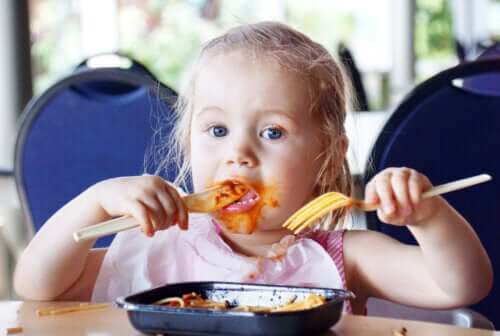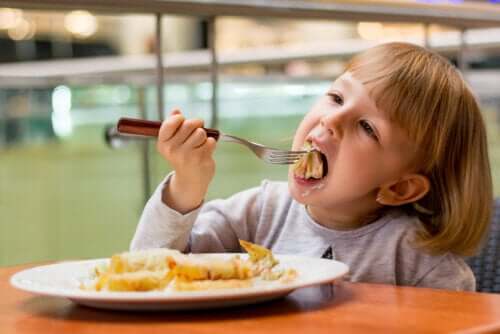Why Get Children Used to Eating Like Adults?

The weekend is the perfect opportunity to eat out with your kids. And, although the children’s menu is the easy option for them to eat, it’s not usually the healthiest. That’s why it’s good to get kids used to eating like adults.
Is the children’s menu a good idea?
Generally, children’s menus tend to include fried foods, such as croquettes, battered chicken breast, or chicken tenders accompanied by French fries. Or a good plate of pasta with tomato sauce, bolognese sauce, cream, or butter. And, for dessert, some ice cream or chocolate cake.
The children’s menu also often includes a soft drink or juice to drink instead of water. This means ingesting a large number of calories in one sitting from fat, refined carbohydrates, and added sugars. In this way, they’re more palatable and produce pleasure.
Furthermore, many restaurants make the mistake of giving children toys. However, in doing so, they coerce the child’s own freedom of choice.

But the question is: Why can they only eat these dishes? We’re starting from the premise that children hate vegetables and fish, even though we can educate their palate.
We can’t expect them to accept healthy food without having insisted several times on changing the cooking techniques and always giving them the fried foods and dishes from the children’s menu.
Advantages of getting children used to eating the same as adults
First of all, when we talk about children eating like adults, it’s because of the quality and type of dishes. Children are able to regulate their appetite by eating the quantities they need.
Secondly, we must take into account that eating habits are created during childhood, so it’s good to offer them a wide variety of foods from a very young age. This way, we ensure that they eat healthy and have the freedom to choose their food when eating out.
As a result, they’ll be even more willing to try any food, reducing aversions. It’s also the way to prevent them from falling into monotony when going to a restaurant. In this way, you contribute to getting children used to eating the same way as adults.
The important thing is that they understand that the dishes on the children’s menu are for occasional consumption. That’s because these foods are related to an increased risk of excess weight, obesity, and diabetes.
Options to get children used to eating like adults
You can always share a dish with them, or ask for a dish that contains both a protein food and a salad or vegetables. If you prefer to have a snack, let them choose at least one of the dishes. Among the options to choose from, depending on the type of restaurant, are:

- Fish with vegetables and baked potatoes
- Grilled meat (beef or chicken) with peppers
- Fajitas stuffed with meat, chicken or beans, with salad or sautéed vegetables
- Hummus with veggie sticks
- Chickpeas stewed with spinach
- Scrambled eggs with mushrooms or wild asparagus
- Parmesan eggplant
- Yakisoba noodles with vegetables and chicken
- Rice with artichokes
- Greek salad (with tomato, cucumber, cheese, and olives)
- Hamburger with tomato, cucumber, and lettuce
- Eggplant moussaka
- Toast with tuna and anchovies
- Caprese salad with tomato and cheese
- Pasta with mushrooms and shrimp sauce
In short, it’s best give up the children’s menu, since it’s not nutritionally adequate for their growth and food choices – and even less for their lifelong health.
The weekend is the perfect opportunity to eat out with your kids. And, although the children’s menu is the easy option for them to eat, it’s not usually the healthiest. That’s why it’s good to get kids used to eating like adults.
Is the children’s menu a good idea?
Generally, children’s menus tend to include fried foods, such as croquettes, battered chicken breast, or chicken tenders accompanied by French fries. Or a good plate of pasta with tomato sauce, bolognese sauce, cream, or butter. And, for dessert, some ice cream or chocolate cake.
The children’s menu also often includes a soft drink or juice to drink instead of water. This means ingesting a large number of calories in one sitting from fat, refined carbohydrates, and added sugars. In this way, they’re more palatable and produce pleasure.
Furthermore, many restaurants make the mistake of giving children toys. However, in doing so, they coerce the child’s own freedom of choice.

But the question is: Why can they only eat these dishes? We’re starting from the premise that children hate vegetables and fish, even though we can educate their palate.
We can’t expect them to accept healthy food without having insisted several times on changing the cooking techniques and always giving them the fried foods and dishes from the children’s menu.
Advantages of getting children used to eating the same as adults
First of all, when we talk about children eating like adults, it’s because of the quality and type of dishes. Children are able to regulate their appetite by eating the quantities they need.
Secondly, we must take into account that eating habits are created during childhood, so it’s good to offer them a wide variety of foods from a very young age. This way, we ensure that they eat healthy and have the freedom to choose their food when eating out.
As a result, they’ll be even more willing to try any food, reducing aversions. It’s also the way to prevent them from falling into monotony when going to a restaurant. In this way, you contribute to getting children used to eating the same way as adults.
The important thing is that they understand that the dishes on the children’s menu are for occasional consumption. That’s because these foods are related to an increased risk of excess weight, obesity, and diabetes.
Options to get children used to eating like adults
You can always share a dish with them, or ask for a dish that contains both a protein food and a salad or vegetables. If you prefer to have a snack, let them choose at least one of the dishes. Among the options to choose from, depending on the type of restaurant, are:

- Fish with vegetables and baked potatoes
- Grilled meat (beef or chicken) with peppers
- Fajitas stuffed with meat, chicken or beans, with salad or sautéed vegetables
- Hummus with veggie sticks
- Chickpeas stewed with spinach
- Scrambled eggs with mushrooms or wild asparagus
- Parmesan eggplant
- Yakisoba noodles with vegetables and chicken
- Rice with artichokes
- Greek salad (with tomato, cucumber, cheese, and olives)
- Hamburger with tomato, cucumber, and lettuce
- Eggplant moussaka
- Toast with tuna and anchovies
- Caprese salad with tomato and cheese
- Pasta with mushrooms and shrimp sauce
In short, it’s best give up the children’s menu, since it’s not nutritionally adequate for their growth and food choices – and even less for their lifelong health.
All cited sources were thoroughly reviewed by our team to ensure their quality, reliability, currency, and validity. The bibliography of this article was considered reliable and of academic or scientific accuracy.
- Carlos Casabona. Tú eliges lo que comes. (2016) España,1ªed. Paidós.
- Nissensohn M, Fuentes Lugo D, Serra-Majem L. (2018) Sugar-sweetened beverage consumption and obesity in children‘s meta-analyses: reaching wrong answers for right questions. Nutr Hosp, 35(2): 474-88.
- Gui ZH, Zhu YN, Cai L, Sun FH, Ma YH, Jing J, Chen YJ (2017) Sugar-Sweetened Beverage Consumption and Risks of Obesity and Hypertension in Chinese Children and Adolescents: A National Cross-Sectional Analysis. Nutrients, 9(12).
- Kasparian M, Mann G, Serrano EL, Farris AR (2017) Parenting practices toward food and children‘s behavior: Eating away from home versus at home. Appetite, 114:194-99.
- Castro IA, Williams CB, Madanat H, Pickrel JL, Jun HJ, Zive M (2016) Food ordering for children in restaurants: multiple sources of influence on decision making. Public Health Nutr, 19(13): 20404-9.
- Ziauddeen N, Page P, Penney TL, Nicholson S, Kirk SF, Almiron-Roig E (2018) Eating at food outlets and leisure places and “on the go” is associated with less-healthy food choices than eating at home and in school in children: cross-sectional data from the UK National Diet and Nutrition Survey Rolling Program (2008-2014). Am J Clin Nutr, 107(6): 992-1003.
- Taillie LS, Afeiche MC, Eldridge AL, Popkin BM. (2017) The contribution of at-home and away-from-home food to dietary intake among 2-13-year-old Mexican children. Public Health Nutr, 20(14): 2559-68.
- Machado-Rodrigues AM, Gama A, Mourão I, Nogueira H, Rosado-Marques V, Padez C (2018) Eating away from home: a risk factor for overweight in children. Eur J Clin Nutr, 72(12): 1724-27.
This text is provided for informational purposes only and does not replace consultation with a professional. If in doubt, consult your specialist.








